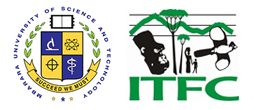Wildlife is one of Uganda’s great natural resources. It is the foundation of its nature-based tourism, one of the nation’s main foreign exchange-earners. At the same time, however, Uganda’s wildlife is under enormous pressure as a result of a fast-growing human population surrounding the remaining wildlife habitats. This leads to conflicts between frontline communities and Protected Areas, their wildlife, and their staff.
Human-wildlife conflicts
Given the improved protection since Bwindi and Mgahinga became National Parks in 1991, wildlife populations have grown and became less fearful of people. For example, a study by ITFC student Mwesigye showed that the foraging range of baboons expanded two-fold within five years after 1991. The animals that normally cause problems here are Baboons, Elephants, Mountain gorillas and Bush pigs. Buffaloes have been particularly troublesome around Mgahinga NP but don’t occur in Bwindi.
To reduce the problem of animals damaging crops many interventions have been tried and promoted. These include the planting of Mauritius thorn hedges, buying up land to create a buffer zone, planting buffer crops such as tea, lemon grass and Artemesia, introducing community-level organized guarding (HUGO), using chilli pepper sprays (against elephants), constructing a wall (at Mgahinga NP, against buffaloes), setting live traps and traditional crop guarding. Also the revenue sharing and gorilla levy programme are viewed as a response to HWC because it compensates communities for such “costs of conservation”.
Over the years, several ITFC researchers studied HWC and useful interventions. These include Akampurila Emmanuel, Andama, Musaasizi, Natukunda, Mwesigye and many more. Most of this work has dealt with identifying the problem animals, the causes of the conflict and ways in which it can be reduced.
Despite all the work that has been done, people still suffer from problem animals and increasingly complain and demand help. The reason is that most non-traditional interventions have been neither very successful nor sustainable. Even when they are successfully initiated and put in place, maintenance breaks down essentially because communities fail to participate.
This stimulated ITFC to look at the problem differently and ask the question ‘how do local people perceive these interventions and why do they not own and embrace them?’ To do this, ITFC designed a study funded by USAID through WCS’ WILD-West Programme.
The study involved interviewing over 500 farmers and conducting several community meetings, to better understand local views, interventions and needs. We are currently developing and fine-tuning recommendations for more effective and sustainable HWC interventions.
The successful uptake and maintenance of interventions require significant investment, but that is not the only condition for success. A comprehensive strategy is needed, involving all stakeholders working together and addressing the complexities and dynamics of communities, which affect intervention management.
To achieve lasting benefits less emphasis must be set on the achievement of the interventions alone (as currently appears to be the case with quantified targets for meters of hedge planted, trenches dug etc) and considerably more emphasis must be placed on the interests and role of the communities themselves and the process by which the intervention is selected, implemented and maintained.
